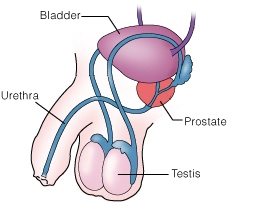Inflammation of the prostate can occur at almost any age. It is often due to infection. Although cystitis – an infection of the urine causing burning and frequency – is more commonly a disease that affects women, these symptoms can occur in men. Such symptoms may be caused by an infection of the prostate called acute prostatitis. This may cause a high temperature and make the patient feel very unwell. In an older man who also has BPH, any prostate symptoms might become worse and prostatitis can sometimes cause retention of urine.
Sometimes an infection of the testicle called epididymitis complicates prostatitis and the symptoms from this might overshadow those from the prostate itself. As with simple cystitis, it is treated with antibiotics. However, the prostate does not take up antibiotics very well and some antibiotics do not work properly inside the prostate. If an infection of the prostate is suspected, the most likely type of antibiotic to be used is called a quinolone – examples are ciprofloxacin (Ciproxin), ofloxacin (Tarivid), norfloxacin (Utinor). It is important that the antibiotic is used for long enough to get rid of the infection completely. This usually means several weeks of treatment. It is important that the full course of antibiotics is taken, even if the symptoms have gone completely, to prevent the infection flaring up again.
Taking plenty of fluids and resting is important while the symptoms are bad. Avoiding sex is probably wise but most patients won’t feel like it anyway while the symptoms are bad! Afterwards, frequent sex might help, as every time a climax is reached the fluid from the prostate may flush out any remaining infection. Rarely an abscess might develop. This is treated by letting out the pus by an operation very similar to a TURP.
 Chronic Prostatitis
Chronic Prostatitis
This can lead to occasional flare-ups of cystitis symptoms or cause more chronic pain. Such pain occurs in the lower abdomen, the testicles, between the legs or even in the back passage. Chronic prostatitis can be very difficult to diagnose, as the symptoms it produces can be due to all sorts of conditions, not necessarily involving the prostate. If they are caused by prostatitis, the prostate may be tender on examination. The doctor may try to grow bacteria from the prostatic fluid, which can be obtained by massaging the prostate or by getting a sample of semen.
Sometimes the prostate is inflamed, but does not seem to be infected by bacteria. The cause of this type of prostatitis is not really understood but the symptoms are sometimes helped by anti-inflammatory drugs such as ibuprofen (Brufen, Nurofen) or indomethacin (Indocid) – although many similar drugs might be used.
Prostatodynia
Similar symptoms to those of prostatitis are caused by a condition called prostatodynia. This probably results from spasm of the muscle in the prostate and certainly many men who suffer from it are helped by the same alpha-blocker drugs that are used in BPH.
Conditions caused by muscle spasm are often aggravated by anxiety and stress, and some men do find that their symptoms are likely to occur if, for example, they are having a difficult time at work. Worry about the condition itself can also make it worse. In such cases it is very helpful to have the prostate checked out and be reassured that there is nothing else wrong with it. It is very unusual for pain in the prostate to be caused by cancer.
Other Causes of Prostatitis
Remember that prostatitis can be very difficult to diagnose and its symptoms are not very specific. You might be referred to a urologist to see if you have prostatitis. If he finds nothing wrong you may be referred to another specialist to make sure that there is no other cause of your symptoms.
Key Points
– Inflammation of the prostate (prostatitis) may be caused by infection.
– Treatment is usually with antibiotics.
